Together in Discovery
October 22, 2020
By Audrey St. Clair ’03
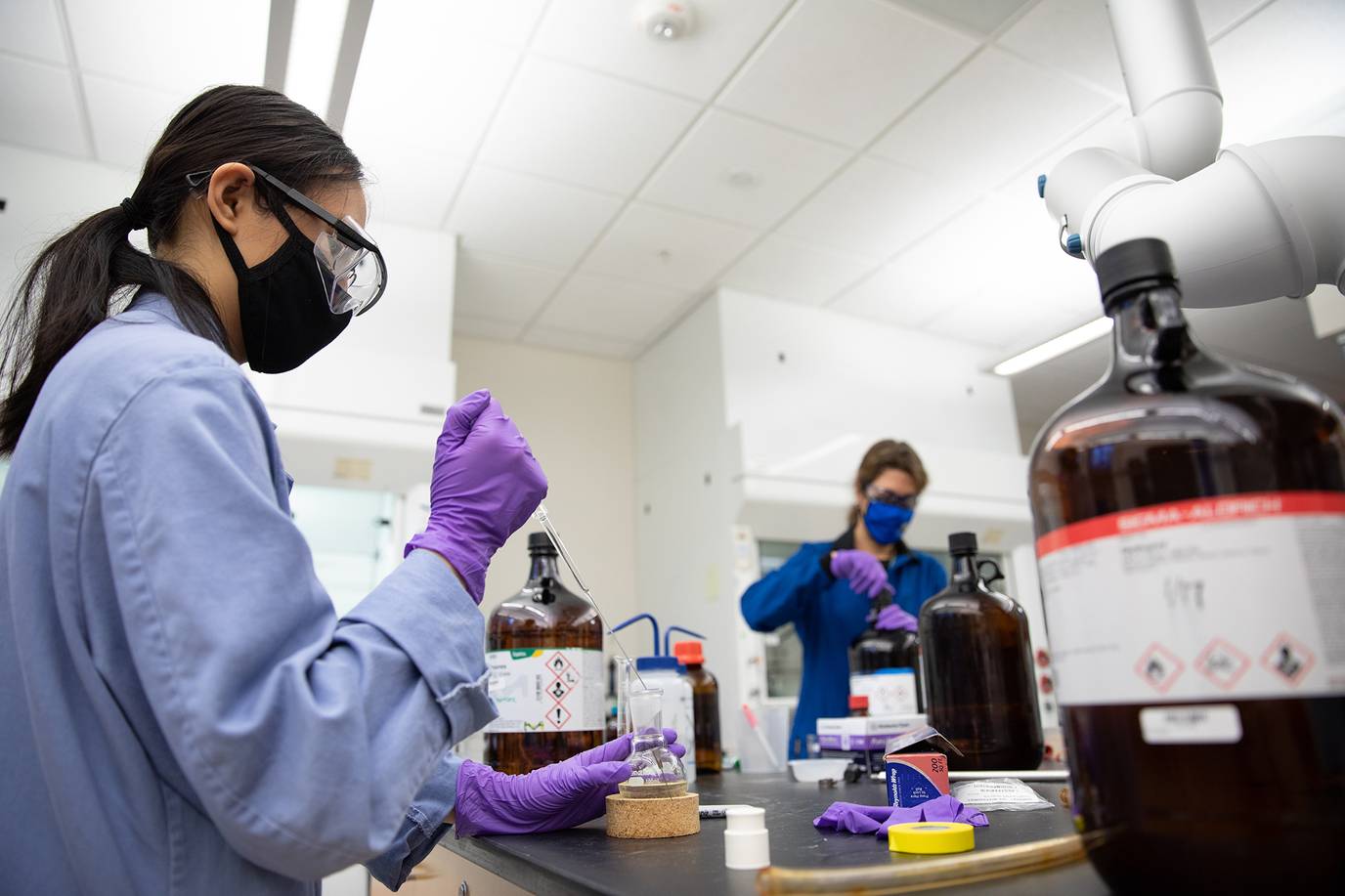
This past summer, Rollins’ Student-Faculty Collaborative Scholarship Program produced some of its most powerful partnerships to date, showcasing the innovative ways our students and faculty are tackling real-world, relevant issues.
Synthesizing silver compounds for potential therapeutics. Identifying food deserts through spatial analysis. Examining the misappropriation of slavery in popular culture. Despite the challenges presented this past summer due to the COVID-19 pandemic, our industrious students and inventive faculty teamed up through Rollins’ Student-Faculty Collaborative Scholarship Program to focus on the important work of finding solutions and solving mysteries.
Through this unique program, Rollins undergrads have the opportunity to engage in the kind of original scholarly research that’s typically available only at the graduate-school level. Many of the students who participate in the program enter grad school having already published an article in a journal and having presented at an academic conference.
Between 35 and 60 proposals are submitted every year—about 45 percent in humanities and social sciences, the rest in natural sciences. Of those, an average of 40 are funded from an annual program budget of about $250,000, which consists of alumni donations and institutional funds. Since the program began, more than 600 students and 100 faculty have participated, and almost every department has been represented, tackling topics as diverse as artificial intelligence and galaxy formation.
“Many colleges have research opportunities for students,” says physics professor Chris Fuse, who has helmed the program since 2010. “What makes our program stand out is that we never think of our students as doing a little bit of work here and there. They’re side by side with us; they’re doing the major research with us. What we want is that our students will be there for the inception of the program through the completion.”
The Student-Faculty Collaborative Scholarship Program celebrated its 20th anniversary this past year, an enduring testament to the power of hands-on experience and meaningful mentorship in creating nimble, resilient leaders prepared not only to find answers to questions that already exist, but to pose new ones as they strive to create a better future.
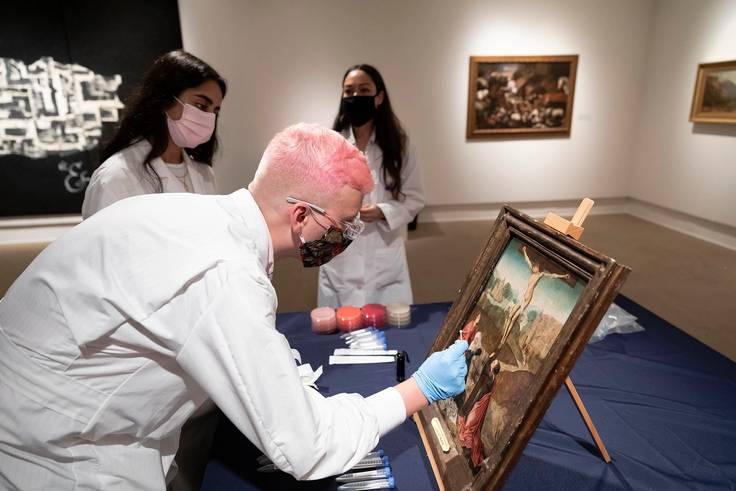
Chemotaxis and Cochineal: Cultivation of Bacteria from Paintings
Research Team
- Brendaliz Santiago-Narvaez, assistant professor of biology
- Isaac Gorres ’21, double major in biochemistry/molecular biology and art history
The Scoop
Putting his dual passions for art and science into practice, Isaac Gorres ’21—a double major in biochemistry/molecular biology and art history—worked alongside biology professor Brendaliz Santiago-Narvaez to examine the microbial flora of an old master painting in one of the Cornell Fine Arts Museum’s collections. The project further crystallized Gorres’ plans to pursue a PhD in conservation research and a career in contemporary art conservation, a discipline that centers on employing analytical techniques and treatment methodologies in a museum setting to aid in the preservation of artworks.
The pair collected swabs from the surface of Marcellus Coffermans’ The Crucifixion with Saint John, the Virgin Mary, and Mary Magdalene (circa 1550) to see if they could isolate bacteria and test whether the pigments in the painting could support bacterial growth. The goal, explains Santiago-Narvaez, was to see whether they could demonstrate that bacteria isolated from the painting could use carmine red pigment as a food source for growth, which would indicate that these microbes could be responsible for the degradation observed in the painting. Gorres—who earned a 2020 Goldwater Scholarship—based his proposal for the Goldwater on this work, the ultimate goal of which is to develop a low-cost, easily reproducible procedure for museums to employ as a first step in heading off microbial degradation.
“What surprised us was that we didn’t isolate that many different microbes from the painting but that what we did isolate had unique growth characteristics,” says Santiago-Narvaez. “For instance, the microbe could only grow when the carmine red was provided as a carbon source. Because of the problems with cultivation, we changed the direction of our project and were able to successfully identify the mystery microbe using different techniques. Isaac was very resilient and was able to pivot the focus of his work on demand and use a combination of approaches to solve the problem. In all ways this project really reflects the spirit and beauty of a Rollins liberal arts education.”
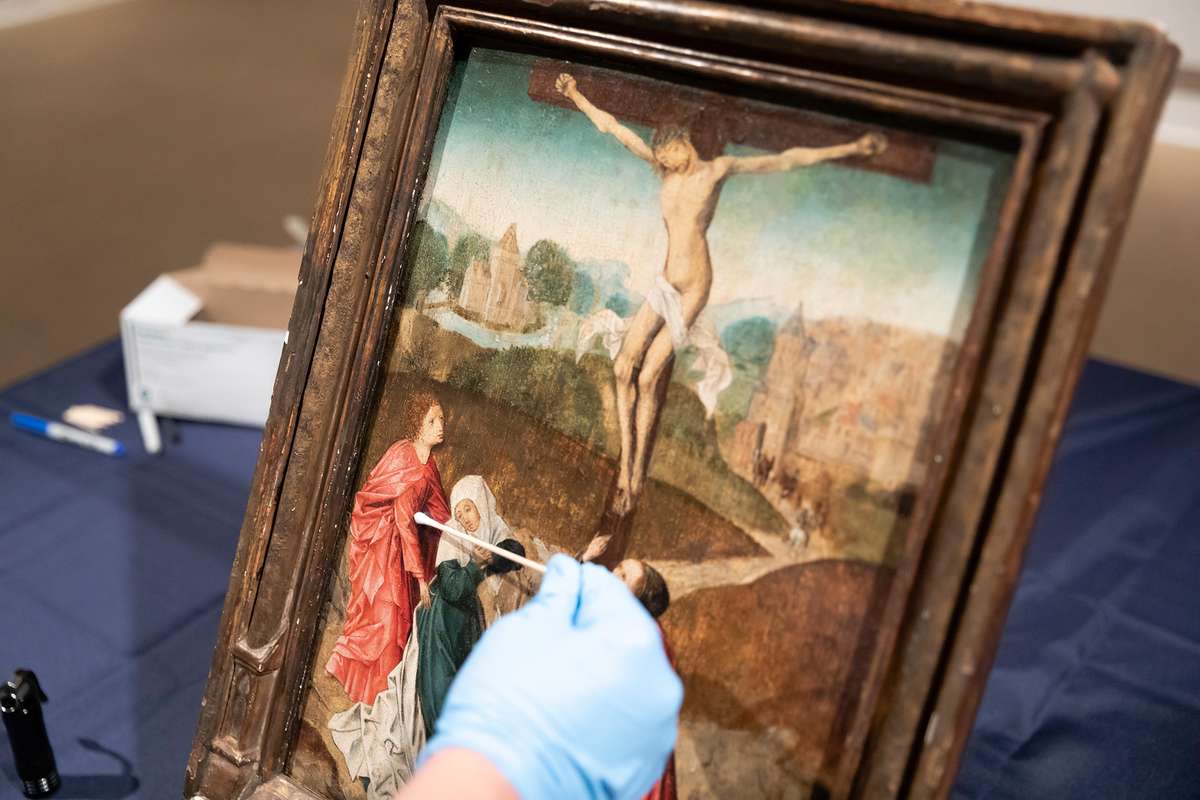
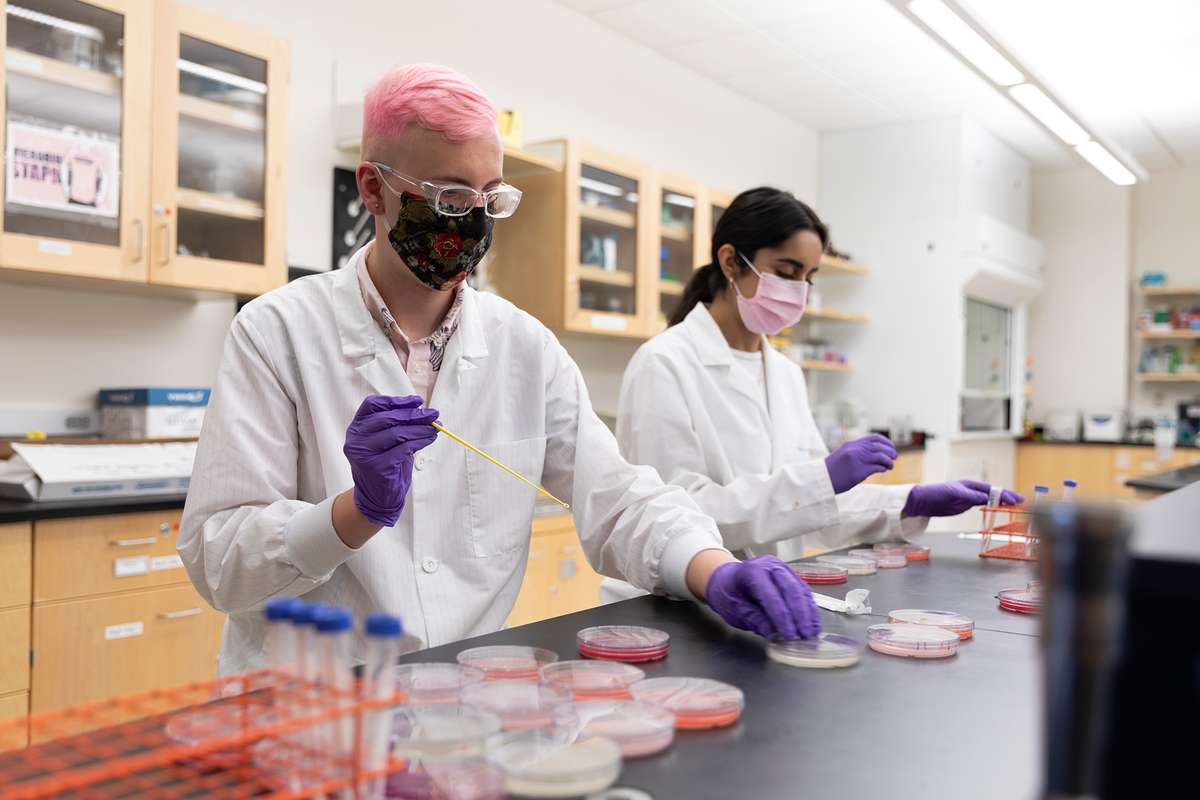
Real-World Application
The study of the “microbiome of things” is a rapidly growing area of research that entails identifying the microbes that are present and differentiating between the good and bad ones in order to develop strategies for putting them to use.
“By applying these types of techniques to art conservation, we can work toward eliminating the species that affect the integrity of the artwork so we can conserve it,” says Santiago-Narvaez. “If you know what’s there and what it’s doing, you can prevent the bacterial degradation. This work can also provide information on what types of bacteria are commonly found on paintings.”
Student Perspective
“Through this experience, I learned that scientific research is full of obstacles that can be difficult yet exciting to unravel,” says Gorres, who plans to dive even further into the world of microbes by pursuing a master’s in microbiology through the Fulbright program at Radboud University in the Netherlands. “This program is different from lab classes because together with a faculty member I was able to analyze a problem that explicitly relates to my ultimate career trajectory in art conservation and conducted actual, novel research.”
What’s Next?
Gorres and Santiago-Narvaez plan to report a successful identification of the isolate from the painting in a microbiology conservation journal. To expand the summer research, Gorres is also working on a bridge project with biology professor Pamela Brannock in which they’re trying to identify as many of the microbes as possible from the same painting using genetic barcoding.

A Prison of Our Own Sins: The Unacknowledged Legacy of 19th-Century Slave Narratives in Westworld and The Handmaid’s Tale
Research Team
- Paul Reich, associate professor of English
- Emily O’Malley ’22, English major
The Scoop
Learning how to think critically about the world is a hallmark of a Rollins education and perhaps more important than ever as we consume mass amounts of media in multiple forms at an exponential rate. Are we really thinking about what we’re watching? Are we paying attention to how the racial and political reckonings that are upon us are playing out in contemporary media? These are just a couple of the big questions English professor Paul Reich and English major Emily O’Malley tackled as part of their summer research that examined the legacy of the 19th-century slave narrative genre against two popular TV series, Westworld and The Handmaid’s Tale.
When Reich, a media critic, started watching these shows, he couldn’t help but think about the connections between his graduate research in 19th-century African American literature and history and the dystopian worlds presented in Westworld and The Handmaid’s Tale. What he noticed was a problematic positioning of the white woman as the enslaved—an issue that not only resonated with O’Malley, but one that has revealed to her how she can use her privilege as a college-educated white person to turn the loudspeaker on to historically unheard voices and work toward a better, more respectful, more intersectional world.
“While The Handmaid’s Tale’s June and Westworld’s Dolores are marketed as universal heroines for women, particularly in this cultural moment, the visual narratives neglect the intersectionality of Black women in stories of oppression,” says O’Malley. “We argue that it’s not impossible for a television series to center the experiences of Black women—in fact, examples like Watchmen and Lovecraft Country do so successfully. The issue with The Handmaid’s Tale and Westworld is not their focus on white women, but rather their refusal to explore the unique positionality of Black women in stories of female oppression and the complex legacy of African American enslavement in the United States.”
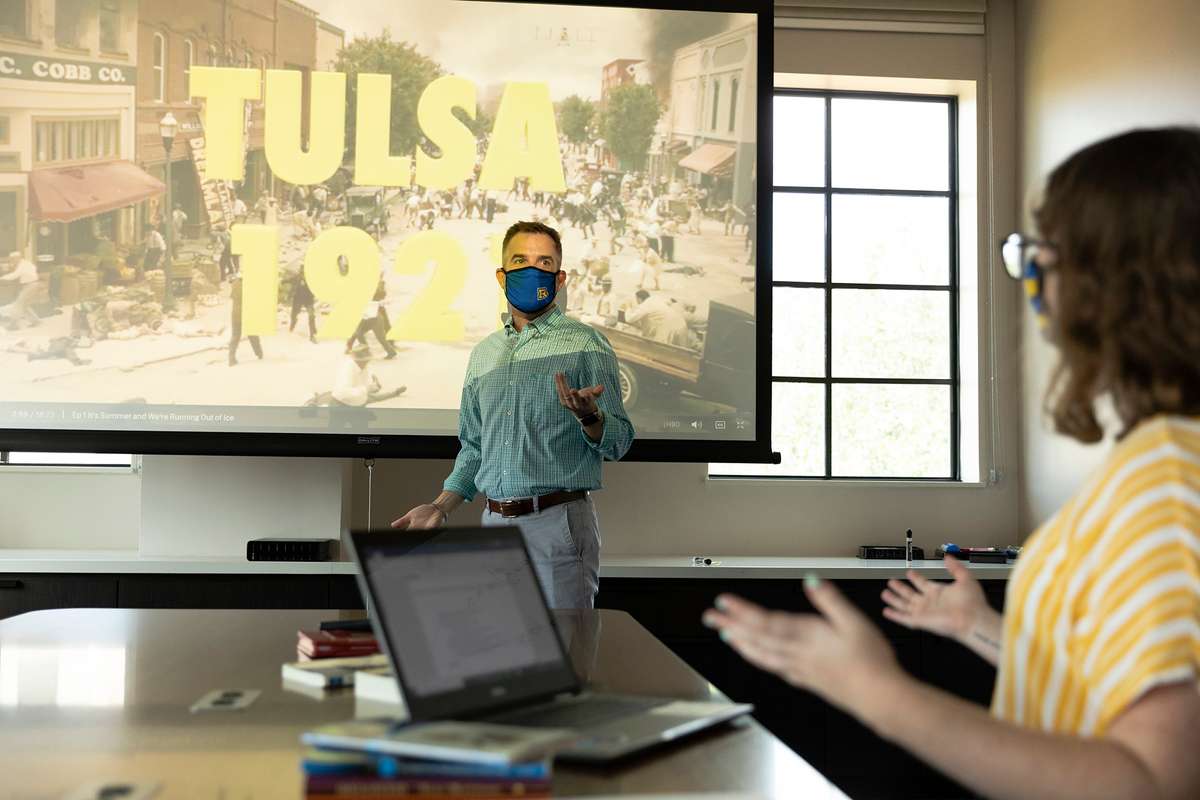
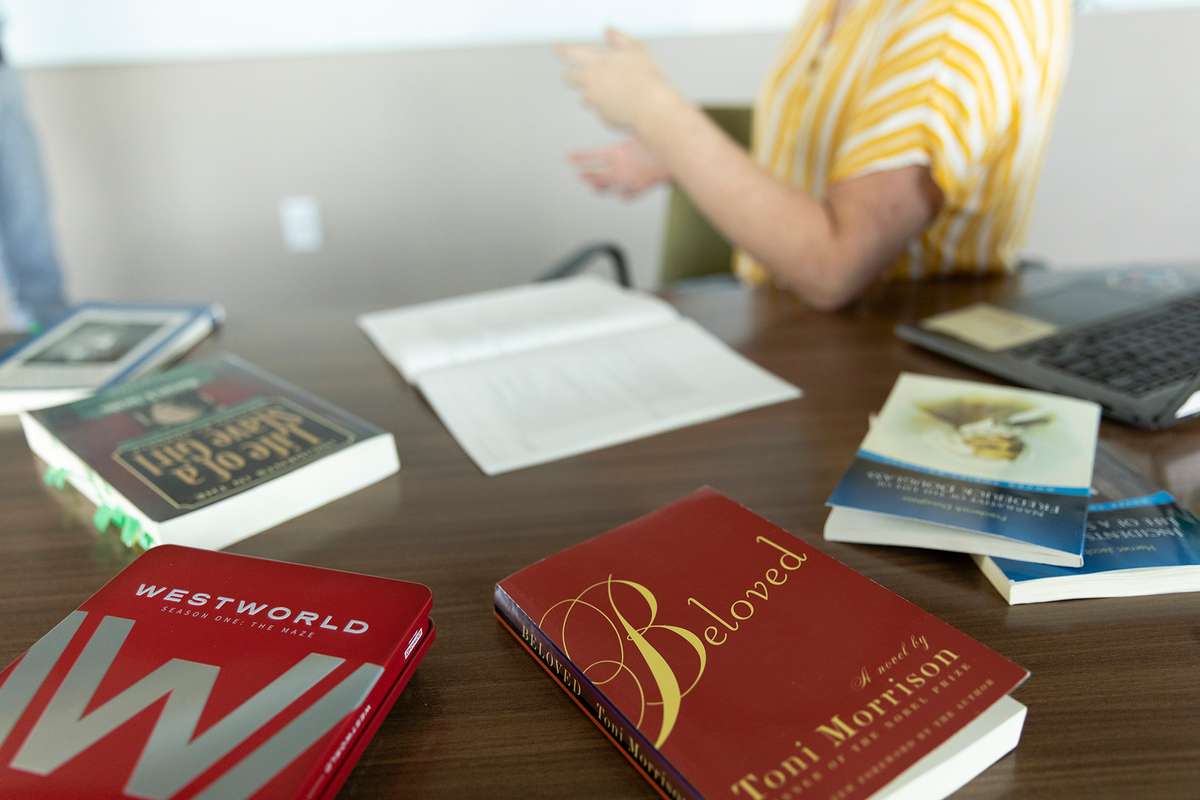
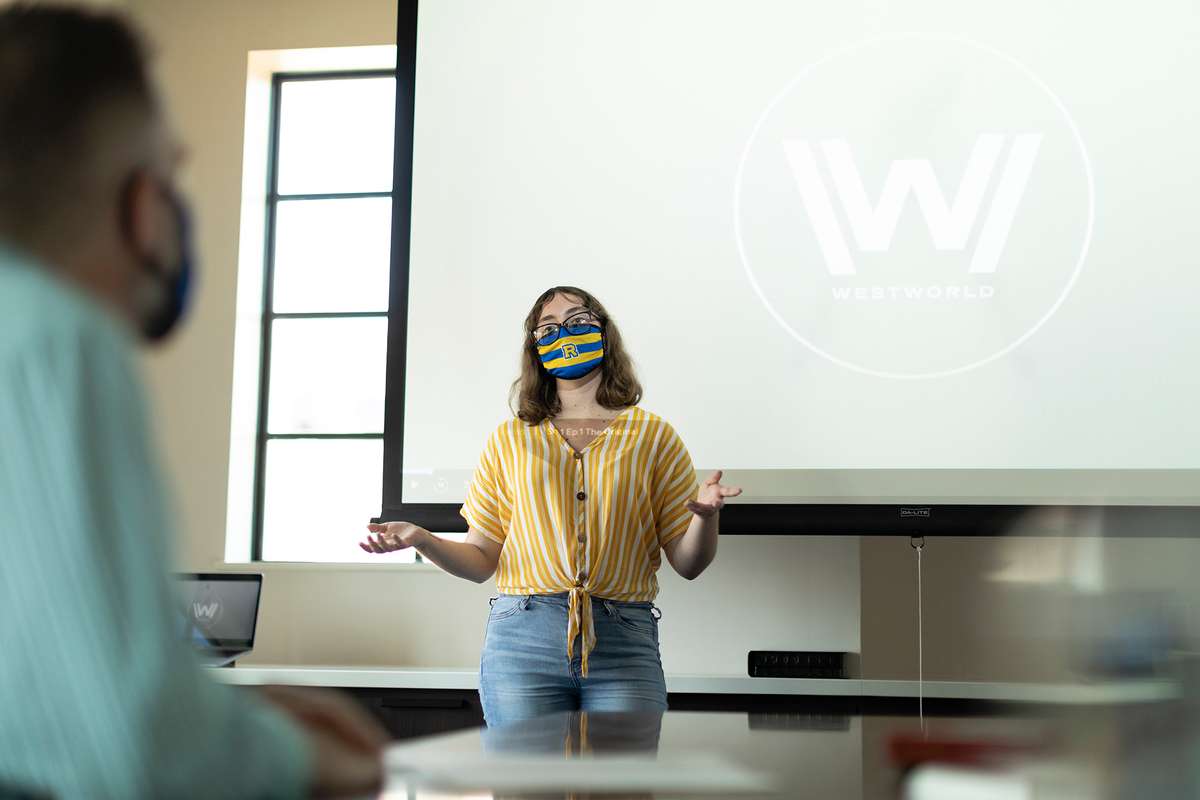
Real-World Application
Addressing the insidious ways that systemic racism informs our media consumption is an essential tool in combating it and reshaping America’s narrative going forward.
“This research will make me teach these shows much differently,” says Reich, who’s hopeful their published research will contribute to the larger critical conversation on contemporary media. “I imagine I’ll be teaching all of HBO’s programming using this lens, and my students will then start evaluating the media they consume and consider how the creators of these shows may rely on generic elements for their own purposes without considering the damage that appropriation might do.”
Student Perspective
“This experience sharpened my analytical eye and taught me exactly what it takes to work as an academic researcher,” says O’Malley. “This topic is especially important to me because I’m part of the target demographic for these visual narratives. Until I started thinking critically about these series with Dr. Reich, I took in that harmful messaging, but now I’m doing the work to unlearn it. It’s not the responsibility of our Black neighbors, friends, and colleagues to teach us about misappropriation and systemic racism—it’s our responsibility as consumers of media to assess what we view, how it negatively affects us, and how we can do better to unlearn those biases.”
What’s Next?
Reich and O’Malley’s research has already been selected for publication in the winter 2021 issue of Popular Culture Review, a peer-reviewed scholarly journal published by the University of Nevada, Las Vegas. Now the pair is planning the sequel. Their current research leaves off by briefly discussing the ways in which two additional HBO series, Watchmen and Lovecraft Country, are tackling history, dystopia, and the Black experience in an appropriate way. Reich and O’Malley plan to apply to the Student-Faculty Collaborative Scholarship Program again next summer to continue their timely, important work.
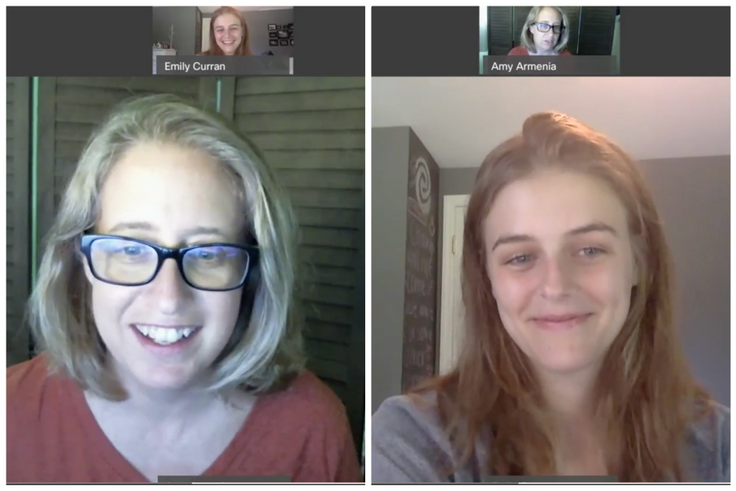
Food Assistance Deserts in Central Florida: Identifying Service Gaps Using Spatial Analysis
Research Team
- Amy Armenia, professor of sociology
- Emily Curran ’22, sociology major
The Scoop
Sociology professor Amy Armenia and sociology major Emily Curran didn’t miss a beat when they learned they’d have to shift their research to a virtual environment this past summer due to COVID-19. WebEx conferences filled in for their spot in Cornell Hall, and screen sharing stood in as a replacement for in-person collaboration.
In partnership with the Second Harvest Food Bank of Central Florida, Armenia and Curran joined forces to combine the nonprofit’s data with U.S. Census data using geographic information systems to analyze where food-assistance programs are out of sync with populations in need. What followed were hours spent processing and analyzing data, manipulating statistical software, collaborating on the analysis programming, brainstorming interpretations, and troubleshooting problems, especially related to the mapmaking portion of the project.
“Looking at geographic barriers to understand access to food assistance allows us to identify areas where community-based aid is lacking,” says Curran. “Ultimately, food assistance is a temporary solution for larger structural inequalities, but the consequences of inaccessible food assistance are large. Although our data focus on the stats of food assistance prior to COVID, working on this project during the pandemic has highlighted potential avenues for further research.”
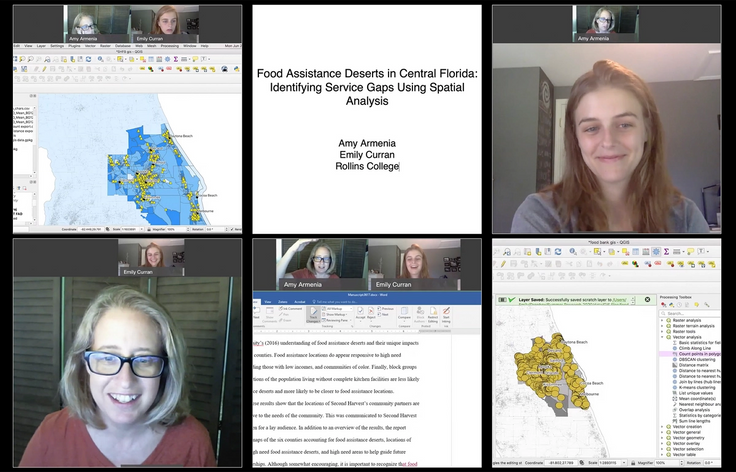
Real-World Application
Working with a community partner to solve actual problems they’re facing is the very definition of real-world application—a notion baked into Rollins’ signature brand of liberal arts education.
“Collaborating with the Second Harvest Food Bank strengthened our long-term relationship and allowed us to provide them with research they can actually use,” says Armenia. “We found that once we developed the analysis skills using the spatial analysis software and got to know the Census data formats, we had a model for research that could be used to help any social service agency with data-driven practices. We analyzed food-assistance access, but you could just as easily analyze the availability of child care or health-care services in relation to high-need populations.”
Student Perspective
“I’m passionate about using empirical research to solve social problems,” says Curran. “Research is tough, and there are a lot of external factors that contribute to the success of a project, so experiencing the process firsthand has been important for my growth as a student and has encouraged me to create more realistic goals. Having this opportunity at the undergraduate level is unheard of, and I know it will help me reach my academic and career goals.”
What’s Next?
The pair’s research will be published in the Journal of Applied Social Science, and they plan to present their work at a regional sociology conference in the spring.
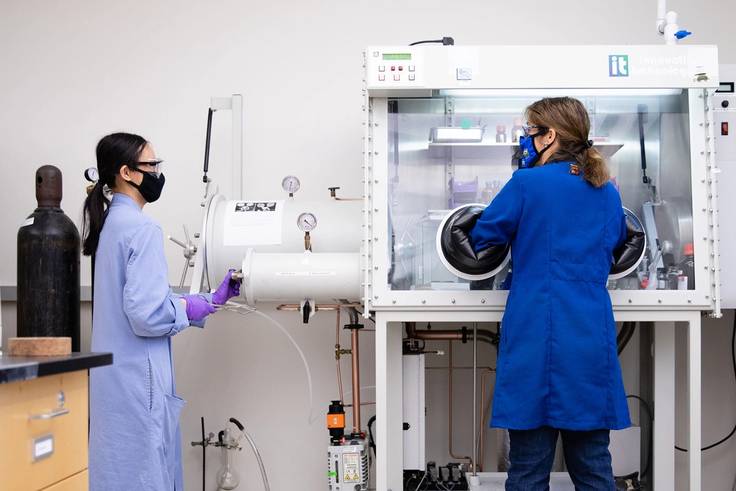
Syntheses of a Series of Ag(I)-NHCs for Future Antibacterial Studies
Research Team
- Laurel Habgood, professor of chemistry
- Alyssa Malto ’21, chemistry major
The Scoop
Thanks to its broad-spectrum antimicrobial properties, silver has been used for medicinal purposes for at least six millenia, but medicinal silver use largely declined following the advent of antibiotics in the early 20th century. With the rise of antibiotic-resistant pathogens in recent years, there has been a renewed interest in silver and silver-containing compounds as potential therapeutic alternatives.
Chemistry professor Laurel Habgood and chemistry major Alyssa Malto ’21 set out to synthesize biologically active silver complexes using N-heterocyclic carbenes, each of which have different structural features that impact the shape, electronic properties, or charge distribution of the complex. Once the team synthesizes and characterizes all the target complexes, they’ll hand them off to their research collaborators for the next phase of the project, which involves analyzing the effect of the compounds on bacterial growth.
“Alyssa is one of the few research students I’ve had the opportunity to work with who has shaped her project from the beginning,” says Habgood. “Her ability to analyze literature and persevere in the laboratory when things don’t work the first time is exceptional.”
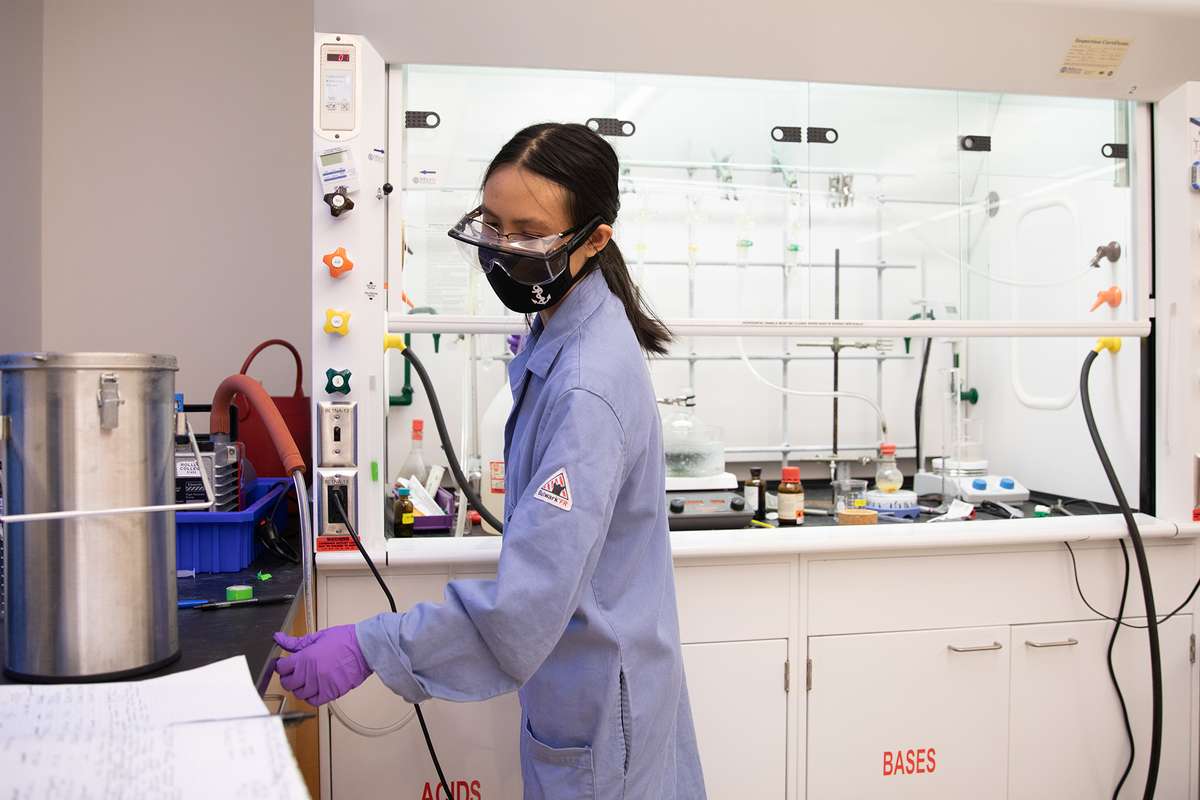
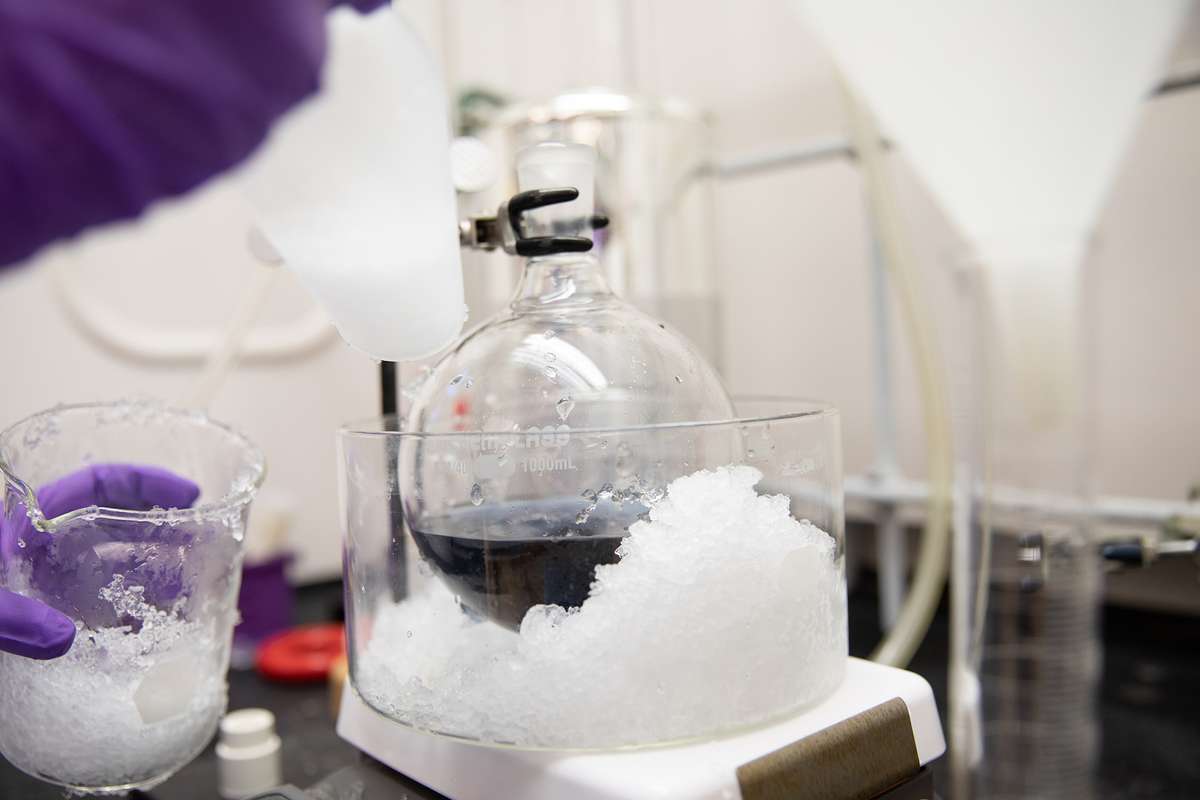
Real-World Application
Likely next summer, the silver compounds Habgood and Malto are producing will be given to fellow student-faculty researchers—biology professor Brendaliz Santiago-Narvaez and biology major and pre-dental student Sarah Hameer ’21—to help them determine whether or not the compounds are effective at killing S. mutans, the bacteria that causes dental cavities.
“I really enjoy learning about the medicinal and biological applications of chemistry,” says Malto, who plans to pursue a career in medicine. “This project is, by nature, multidisciplinary, so it’s really cool to be able to see how these different subfields of chemistry—namely medicinal, inorganic, and organic—can all come together to solve a microbiological problem.”
Student Perspective
“Experiments don’t always work out, and it can be frustrating when that happens,” says Malto. “However, being able to bounce back from failure and think of different ways to tackle the problem at hand and actually be successful is very satisfying. Dr. Habgood gave me so much freedom, and as a result, I really feel like the project is my own. The independence she has given me both in and out of the lab has allowed me not only to learn from my mistakes, but also to mature as both a scientist and a person.”
What’s Next?
The main priority is to finish synthesizing the remainder of the complexes in the series before handing them off to their collaborators. What happens next will depend on the results they generate. The pair plans to submit their research either to the Journal of Dental Research or Antimicrobial Agents and Chemotherapy. They will then continue to explore the literature looking for new bioactive transition metal complexes that can be synthesized and evaluated for antimicrobial properties.
Keep Exploring
Read more about Rollins’ Student-Faculty Collaborative Scholarship Program, which has been proliferating powerful partnerships for more than 20 years.
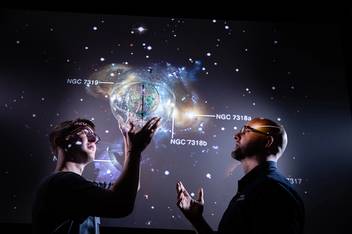
October 22, 2019
Two Decades of Discovery
Rollins’ Student-Faculty Collaborative Scholarship Program is celebrating its 20th anniversary this year. To mark this milestone, we’re looking back at 20 of the program’s most significant accomplishments.

October 08, 2018
Allies in Inquiry
This past summer, students and faculty joined forces in tackling some of their fields’ toughest issues as part of Rollins’ Student-Faculty Collaborative Scholarship Program.
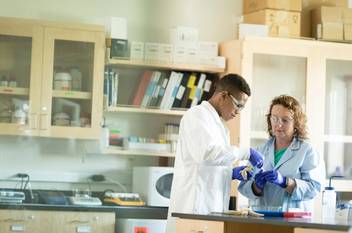
October 16, 2017
Better Together
For eight weeks this past summer, students and faculty worked side by side to tackle some of their fields’ most pressing issues through Rollins’ Student-Faculty Collaborative Scholarship Program.
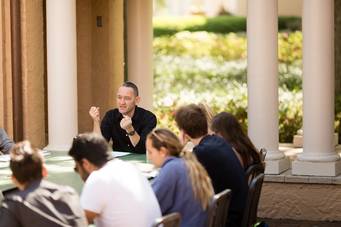
See for Yourself
Get a feel for Rollins’ unique brand of engaged learning and personalized attention through one of our virtual or in-person visit experiences.
Read More
May 22, 2024
Earth Charter International Conference Held at Rollins
In April, Rollins played host to the fifth annual Earth Charter Conference, a three-day event focused on education for sustainability and global citizenship and for planetary well-being.
March 18, 2024
The Meaning of a Good Life
After attending seven colleges across three decades, Eric Reichwein ’18 discovered Rollins’ Professional Advancement programs and the quality of life he’d always wanted.
March 14, 2024
How I Advanced My Career: Eric Reichwein ’18
Find out how Eric Reichwein ’18 leveraged the personalized learning environment and top-ranked reputation of Rollins’ Professional Advancement programs to finish his bachelor’s degree and build the life and career he’s always dreamed of.
